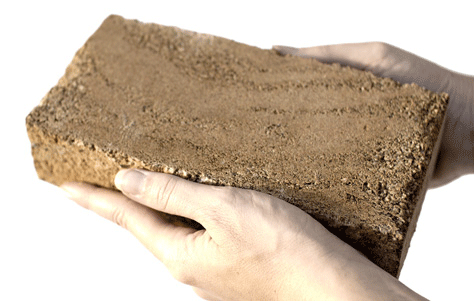Biomanufactured Brick by Vergelabs
An American architecture professor, Ginger Krieg Dosier, is thinking of sustainability on a micro-scale that has the potential to impact the design world on a global scale. Biomanufactured Brick is her creation which won the Metropolis 2010 Next Generation Prize Challenge. “ONE DESIGN FIX FOR THE FUTURE” was the topic of the challenge, and Professor Dosier’s genetically engineered brick is capable of such change.
Biomanufactured Brick. Designed by Ginger Krieg Dosier for Vergelabs.
“The ordinary brick – you would think that there is nothing more basic than baking a block of clay in an oven, Ginger Dosier’s idea is the perfect example of how making a change in an almost unexamined part of our daily lives can have an enormous impact on the environment.” – Horace Havemeyer, Publisher of Metropolis

Bricks may seem like on of the more innocent bystanders of the construction industry, but the sheer volume of bricks manufactured every year (1.3 trillion) combined with their carbon output of 1.4 pounds of carbon per brick for the 10% are made by hand in coal-fired ovens is substantial. Dosier’s process removes baking from the equation and replaces it with simple mixing and bacterial interaction. The bacteria induce calcite precipitation in the sand and yield bricks with sandstone-like properties.
Because the process requires no technology once the bacteria is made, bricks can be created onsite in localities without modern infrastructure. “If biomanufactured bricks replaced each new brick on the planet, it would save nearly 800 million tons of CO2 annually.” (Bustler)
via Bustler
About the Designer: Ginger Krieg Dosier, 32, is an Assistant Professor of Architecture at American University of Sharjah (AUS) in Abu Dhabi. She was trained as an architect at Auburn University’s Rural Studio, once headed by Samuel Mockbee, and Cranbrook Academy in Michigan. Her interest in science has developed further whilst teaching at North Carolina State University, where she studied microbiology, geology, and materials science in her spare time. She is the co-founder of Vergelabs, an architecture and design practice with a focus on developing performative research topics in architecture


Leave a Reply